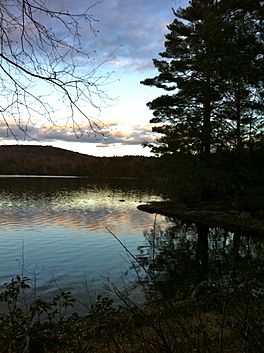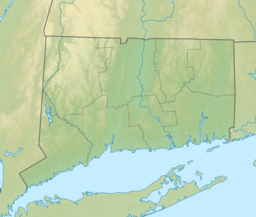Mashapaug Lake facts for kids
Quick facts for kids Mashapaug Lake |
|
|---|---|

Bigelow Hollow State Park looking north from the southern shore of Mashapaug Lake at sunset.
|
|
| Location | Union, CT, United States |
| Coordinates | 42°01′00″N 72°08′00″W / 42.0167°N 72.1333°W |
| Type | Reservoir |
| Primary inflows | Wells Brook, several intermittent streams |
| Primary outflows | Bigelow Brook |
| Basin countries | United States (Connecticut and Massachusetts) |
| Max. length | 1.67 mi (2.69 km) approx. |
| Max. width | 0.57 mi (0.92 km) approx. |
| Surface area | 297 acres (120 ha) |
| Average depth | 15 ft (4.6 m) |
| Max. depth | 39.5 ft (12.0 m) |
| Water volume | 1.45 billion US gallons (5.5 Gl) |
| Surface elevation | 706 ft (215 m) |
| Frozen | December through March (most winters) |
| Islands | Several |
Mashapaug Lake is a beautiful lake in northeastern Connecticut. It covers about 297 acres (1.2 square kilometers). The lake is surrounded by Bigelow Hollow State Park and Nipmuck State Forest in the town of Union.
Mashapaug Lake is a popular spot for fishing, boating, and swimming. Its deepest point is about 39.5 feet (12 meters), and its average depth is 15 feet (4.6 meters). The lake's surface is usually 706 feet (215 meters) above sea level.
Contents
How Mashapaug Lake Was Formed
Mashapaug Lake started as a natural lake. Over time, people built two dams to help control its water level. One dam is at the northern end of the lake. It helps send water into the Quinebaug River system.
The other dam is at the southern end. This dam lets water flow into Bigelow Brook. Water always flows over the southern dam. The northern dam is mostly used in winter to lower the lake's water level.
What the Lake Bottom is Like
Most of Mashapaug Lake's bottom is made of gravel and sand. You might also find some scattered rocks, trees, and tree stumps. In the deeper, flat parts of the lake, the bottom is softer. It has fine sand, silt, and organic muck.
Wells Brook and several small streams feed water into Mashapaug Lake. The lake usually drains south into Bigelow Brook. However, when the water level is lowered in winter, water is pumped north into the Quinebaug River system.
Homes Around the Lake
You can find some houses along the shores of Mashapaug Lake. There are also homes on two of the islands in the lake. The northern and northwestern parts of the lake have more houses than other areas.
Where there are no houses, the lake's shoreline is covered with thick forests. Bigelow Hollow State Park surrounds the southern and southwestern parts of the lake.
Fun Things to Do at the Lake
Mashapaug Lake is open for everyone to enjoy. It's a great place for fishing and boating. During the winter, ice fishing is a very popular activity on the frozen lake. You can also go swimming in the lake when the weather is warm.
Visitors can get to Mashapaug Lake through Bigelow Hollow State Park. The park is located at the southern end of the lake. There's also a special place there where you can launch your boat.
Plants and Animals of the Lake
Not many plants grow in most parts of Mashapaug Lake. However, you can find more plants in the shallow areas. When the lake's water level is lowered in winter, more plants start to grow along the shoreline.
Some plants you might see in the shallow waters include yellow pond-lily, pickerel weed, and different types of pondweeds.
Many kinds of fish live in Mashapaug Lake. These include sunfish, yellow perch, chain pickerel, largemouth bass, and smallmouth bass. You can also find brown trout, rainbow trout, and channel catfish. The Connecticut Department of Environmental Protection adds brown and rainbow trout to the lake regularly.
Mashapaug Lake is famous for two state fishing records! In 1961, the heaviest largemouth bass ever caught in Connecticut was found here. It weighed 12 pounds and 14 ounces. Then, in 2004, the heaviest channel catfish in the state was caught in the lake. It weighed an amazing 29 pounds and 39 ounces!


